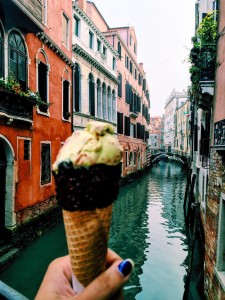For November I went to Italy,Normandy and Strasbourg, France.
Reflecting over the last month of collecting information for my theme of Vitamin D and sunlight exposure, I’ve found people get their daily dose of vitamin D from food sources and sunlight exposure.
From all the research articles I read over the three months I was able to come to a personal conclusion that to keep my vitamin D levels up I had to expose myself to sunlight more frequently. I also have to consume foods rich in Vitamin D such as meats and dairy products.
I did comparisons from Vitamin D intake of United States people and European people.
In the USA and Canada “Less than 2% of participants in all age groups met the 2011 Recommended Daily Allowance (RDA) for vitamin D from foods. ” (Hill, 2012). In The USA and Canada milk, meat and fish were the top food sources for vitamin D. Cereal was a top food source of vitamin D for Americans but not Canadians. This information reminds me of how when I was in the United States most of my morning breakfasts consisted of cereal. Ever since I was a little girl my mom has given us cereal for breakfast. At the beginning it was Trix Cereal or Froot Loops; the very sugary kind made for children. Now as I’m older I try to choose more “healthy” cereals such as Mini Wheats which are said to have great source of fiber.
In both the USA and Canada Vitamin D intake was higher with more frequent cereal and breakfast consumption, “largely attributable to greater milk intake.” (Hill,2012) Practical Application: Most Americans and Canadians do not meet the 2011 Inst. of Medicine recommended daily allowance (RDA) for vitamin D for their age groups from foods. Increasing breakfast and cereal consumption may be a useful strategy to increase dietary vitamin D intake to help individuals meet the RDA for vitamin D, particularly by increasing milk intake.
On the topic of milk, one of the things I learned from both my Human Diet class and this Global Health class was that lactose intolerance is normal for an adult. Over time culture has shaped us into humans that drink milk even though it is not in our biology to do so. The first months that we are born it is normal for us to do so since we are able to produce lactase. Later on many adults have trouble with the sugar found in milk, lactose. Most importantly I learned that lactose intolerance is suppose to be the natural human condition. My whole life I’ve heard we are suppose to drink milk to grow healthy bones and teeth. Milk is a great source of calcium and many vitamins like Vitamin D. I researched therefore the health effects of not drinking milk. Of the articles I found, I learned in one that carcinogesis has been linked “to calcium, growth factors in milk or high estrogens in milk” ( Shrier, 2008). In the case of ovarian cancer it was found lactose persistance status and milk to be positively associated with ovarian cancer. In the case of breast cancer, fat, growth factors and high estrogen content of dairy foods might cause a carcinogenic effect. However, dairy foods are protective towards colorectal cancer.
When I travelled to Italy, I noticed Italians also consume much milk. The milk and yogurt given to us at the two different hotels we stayed as was from the Swiss Alps. Italy as I learned through class has one of the lowest mortality rates. Therefore reading articles that show that certain foods cause cancers or receiving little sunlight is bad for your health makes me wonder to how far we should take the recommendations. I believe a balance is always necessary in all of the meals we eat.
When thinking of my daily vitamin D or sunlight exposure I could be healthy either in France or Italy. Each country has its own ways to tackle health and they put into consideration they pros and cons of their geographic location. For example, the weather in Italy was much warmer than in Angers, France. Of the three cities I visited in Italy, Venice was the coldest. Florence and Rome were sunny and warm. In a study by the European Journal of Nutrition, Northeastern Italian children were at higher risk for Vitamin D deficiency (Marrone, 2012). The risk factors were winter season for blood withdrawal, obesity and non-caucasian race. However, the meditarrenean diet of the Italians is considered one of the healthiest.
In France, it is colder than Italy but the French diet that consists of bread, cheese and vegetables contain their daily source of vitamin D. The French also encourage leisurely walking around the city. Living in a small town like Angers exposes us to sunlight and not as much pollution as in other bigger European cities. Angers also exposes us to local markets with fresh food.
On the other hand, in the United States, we spend most of our time in cars driving around the city. However, living in a lower latitude zone like Texas, we experience more sunlight than other places that I travelled to this month such as Normandy or Strasbourg, France. In conclusion, we can find healthy solutions everywhere we go.
Citations
Marrone, Giuseppina, et al. “Is Vitamin D Status Known Among Children Living In Northern Italy?.” European Journal Of Nutrition 51.2 (2012): 143-149. Academic Search Complete. Web. 14 Dec. 2015.
Hill, Kathleen M., et al. “Top Food Sources Contributing To Vitamin D Intake And The Association Of Ready-To-Eat Cereal And Breakfast Consumption Habits To Vitamin D Intake In Canadians And United States Americans.” Journal Of Food Science 77.8 (2012): H170-H175. Academic Search Complete. Web. 23 Nov. 2015.
http://genetics.thetech.org/ask/ask135
Shrier, Ian, Andrew Szilagyi, and José A. Correa. “Impact Of Lactose Containing Foods And The Genetics Of Lactase On Diseases: An Analytical Review Of Population Data.” Nutrition & Cancer 60.3 (2008): 292-300. Alt HealthWatch. Web. 14 Dec. 2015.
